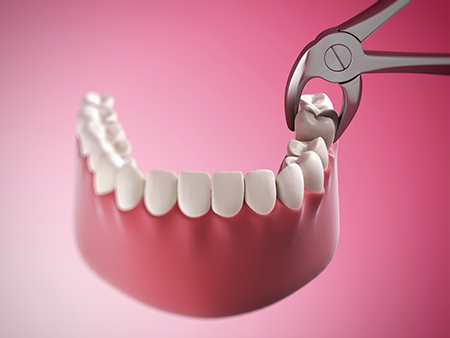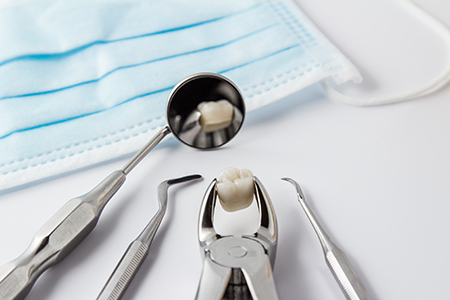Serving Avondale and the West Valley
Serving Avondale and the West Valley

At Summit Family Dentistry, we focus first on preserving natural teeth whenever possible. However, there are circumstances where removing a tooth is the most responsible choice to protect the rest of your mouth and your overall health. When extraction is recommended, it is because the risks of keeping the tooth outweigh the benefits of trying to save it.
A careful evaluation comes before any recommendation for removal. We review your medical history, examine the affected area, and use diagnostic imaging as needed to understand the tooth's condition and how it relates to neighboring teeth and tissues. This approach ensures the decision to extract is based on clinical need, not convenience.
We also consider how a removal will affect chewing, speech, and long-term dental stability. When a tooth must be extracted, the team prioritizes comfort, predictable healing, and a plan for restoring function afterward. You will always be involved in the discussion of next steps so you understand both short-term care and longer-term options.
Primary (baby) tooth that won’t fall out or is damaged
Occasionally a primary tooth remains firmly in place even as the permanent tooth below it tries to emerge. When a baby tooth’s root does not resorb properly or the tooth becomes ankylosed to the bone, it can block normal development. Removing an over-retained primary tooth can help guide the permanent tooth into its correct position and support proper alignment as your child grows.
Permanent tooth too compromised by decay to be restored
Cavities begin at the enamel and can progress inward if not addressed. When decay has destroyed most of the tooth’s structure or infected the nerve to the point that restoration is no longer predictable, extraction may be the safest option to prevent ongoing infection and protect adjacent teeth and tissues.
Severely fractured or cracked teeth that cannot be saved
Not all fractures are equivalent: some can be bonded or covered with a crown, while others extend beneath the gumline or into the root. When a tooth has been structurally compromised beyond repair, removing it can prevent chronic pain, recurring infections, and further damage to neighboring teeth.
Advanced periodontal disease affecting the tooth’s support
Gum disease can gradually erode the bone and soft tissues that hold teeth in place. If a tooth becomes mobile or the supporting bone and gums are too damaged to allow a stable restoration, extraction may be necessary to preserve oral health and allow targeted periodontal treatment to protect surrounding teeth.
Problematic wisdom teeth
Third molars often lack the space to emerge properly and can become impacted, partially erupted, or infected. When wisdom teeth jeopardize nearby teeth, cause recurrent pain, or contribute to cysts or decay, removing them can prevent ongoing trouble and simplify future dental care.
Teeth removed as part of an orthodontic plan
In some orthodontic cases, extracting select teeth helps create the space needed to align the remaining teeth for a healthier bite. When extractions are part of coordinated orthodontic treatment, they are planned and timed precisely to support the desired outcome.

Preparation starts with a comprehensive review of your health and current medications. Knowing your medical conditions, recent surgeries, and any medications or supplements you take helps the dental team reduce risk and tailor care. Some medical situations require coordination with your physician or temporary adjustments to medication before surgery.
We use diagnostic imaging to assess root shape, proximity to nerves or sinuses, and the overall anatomy that influences the type of procedure required. This information determines whether a tooth can usually be removed in a single visit with local anesthesia or whether a more involved surgical approach is needed. We will explain our findings and the rationale for the recommended path.
Patient comfort is a priority. Local anesthesia is standard and, for patients with anxiety or complex cases, additional options such as oral or intravenous sedation may be available. We will discuss the choices, explain what to expect, and provide clear pre-procedure instructions so your day of treatment is as calm and predictable as possible.
A simple extraction is typically performed when the tooth is visible and the root forms are straightforward. After numbing the area with local anesthetic, the dentist gently loosens the tooth with specialized instruments and removes it with forceps. The goal is to minimize trauma to the surrounding tissues while ensuring the tooth is removed safely and completely.
Surgical extractions are used for teeth that are broken at the gum line, impacted, or have complex root anatomy. The procedure often involves making a small incision, removing a bit of bone if necessary, and dividing the tooth into sections for easier removal. Surgical cases may be handled by an oral surgeon when specialized care will improve outcomes.

On the day of the procedure, the team will review your medical history and confirm consent before beginning. We take time to ensure the anesthetic is effective and that you feel comfortable throughout the process. Communication is encouraged — let us know how you are feeling at every step.
For patients receiving sedation, continuous monitoring of vital signs keeps safety at the forefront. Even with local anesthesia alone, we use techniques to minimize pressure and discomfort, and we pause as needed to allow for breaks or to address any concerns. Our clinical approach is focused on efficiency, compassion, and attention to detail.
When the tooth is removed, we place gauze to help form an initial clot and provide immediate post-op instructions. If sutures are required, these are explained and timed for removal or dissolution as appropriate. Before you leave, we’ll review home care, signs to watch for, and when to schedule follow-up if needed.
Healing after an extraction is a gradual process. In the first 24 to 72 hours you can expect some swelling, minor bleeding, and discomfort that improves each day. Following the care guidelines your dental team provides helps reduce complications and encourages predictable healing.
Maintain gauze pressure
Bite gently on the gauze placed over the socket to encourage a stable blood clot. Replace the gauze after the first hour if needed and continue light pressure until active bleeding lessens. Small amounts of oozing can be normal for up to 24 hours; persistent heavy bleeding should be reported to the office.
Protect numb tissues
Until the local anesthesia fades, avoid chewing, and be mindful of the numb lip, cheek, or tongue to prevent accidental biting or injury.
Take medications as directed
Antibiotics:
If an antibiotic is prescribed, complete the entire course as instructed to reduce the risk of infection.
Pain control:
Begin pain management while the anesthetic is present for smoother comfort transition. Use over-the-counter or prescription pain relievers exactly as recommended by your clinician.
Protect the forming clot
Avoid rinsing vigorously, spitting, or using a straw for the first day or two. These actions can dislodge the clot and delay healing. Gentle rinsing with a mild saltwater solution can be introduced when advised by your clinician.
Reduce swelling
Cold packs applied intermittently to the outside of the face for short intervals during the first day can help limit swelling. Keep activity light and elevated head position when resting.
Avoid smoking
Smoking impairs clot formation and slows healing. Refrain from tobacco use for at least the first week to support optimal recovery.
Choose gentle foods and fluids
Start with soft, cool or lukewarm foods and plenty of fluids. Avoid spicy, hot, or carbonated beverages early in recovery and gradually return to a normal diet as comfort allows.
Maintain careful oral hygiene
Continue gentle brushing away from the extraction site and follow guidance about when to begin gentle saltwater rinses. Good hygiene supports healing and reduces the chance of infection.
Attend follow-up visits as advised
If sutures were placed or if the extraction was complex, a follow-up appointment helps monitor healing and address any concerns. Keep scheduled visits so your clinician can confirm recovery is progressing well.
If you notice increasing pain, persistent swelling, fever, or any concerning changes, contact the office so we can evaluate and provide prompt care.

After an extraction, many patients consider how to replace the missing tooth to restore chewing function and appearance. Options include removable prostheses, fixed bridges, and dental implants. Each choice has benefits and specific considerations, and your dentist will explain which solutions best match your oral health, bone levels, and long-term goals.
In planning a replacement, timing and coordination matter. Some restorations can be started soon after healing, while others may require additional preparation such as bone grafting. A thoughtful plan helps preserve bite stability and supports a comfortable, long-lasting result.
Throughout this process, the practice focuses on clear communication and evidence-based recommendations. Summit Family Dentistry will partner with you to select and sequence treatments that address immediate healing needs and return you to full oral function with predictable outcomes.
In summary, tooth extraction is a common dental procedure performed when removal best protects your oral health. Our team approaches each case with careful evaluation, attention to comfort, and a clear plan for recovery and replacement when needed. If you have questions about extractions or want to discuss a specific situation, please contact us for more information and personalized guidance.

The most common reasons for tooth loss include advanced periodontal disease, extensive tooth decay, and facial trauma. According to statistics, gum disease is responsible for close to 70% of tooth loss in adults. Although less frequent than the preceding three reasons, it should also be noted that specific diseases, drugs, smoking, and poor nutrition contribute to the risk of tooth loss.
The Centers for Disease Control and Prevention report that in the United States, an average of 12 teeth (including the wisdom teeth) are lost by the age of 50. Also, 26% of adults between 65 and 74 years of age have lost all their teeth.
Every patient and every situation is different. However, when a tooth and the surrounding tissues are numbed with a local anesthetic, you should only expect to feel a bit of pressure, but no pain as the tooth is being loosened from the surrounding tissues and extracted. For patients who are apprehensive and for some surgical extractions, our office will discuss our options in dental sedation to provide further relaxation and reduce any sense of discomfort.
While it's normal to feel some tenderness and swelling following an extraction, the degree of these sensations can vary. It mostly depends on the complexity of the extraction and the body's response to the procedure. We'll recommend or prescribe the appropriate pain medication to help ensure your comfort and give you specific instructions for maximum effectiveness and safety.
Typically, the recovery period following a simple extraction is shorter than a surgical extraction. However, a patient's overall health, habits, the size and location of the tooth, and other variables can influence recovery and healing. To speed up the recovery and avoid any complications, patients must follow the given at-home instructions diligently. We'll carefully review what to expect following your procedure and go over your post-op instructions.
Smoking interferes with blood clot formation, which is an essential first step in the healing process. Blood clot formation not only provides a protective layer to cover the underlying exposed bone and nerve endings, but it also supports the growth of new tissue. Cigarette smoke also contains chemical toxins that can disrupt the healing process and lead to problems such as continued inflammation, infection, or dry socket.
In a very small percentage of cases, a condition known as dry socket can develop in the aftermath of a dental extraction. This painful condition can arise when the blood clot in the extraction site doesn't form properly or gets dislodged. With dry socket, you may experience throbbing pain and symptoms such as bad breath and an unpleasant taste in your mouth. As skilled providers of care, our office will provide immediate treatment to alleviate your discomfort and promote healing.
The last teeth in your mouth to develop, wisdom teeth often do not have enough room to fully erupt or may be positioned in the wrong direction. These issues can affect your dental health as well as overall wellbeing. While some individuals never develop all their wisdom teeth, and a few have sufficient space for them, there are many people with partially or fully impacted third molars. Our office will monitor the development, position, and health of your wisdom teeth and will advise you if and when extractions are indicated.
After a tooth is removed, bone-grafting material is sometimes placed in the socket to promote healing and encourage new bone development. This procedure is often performed to support the eventual and successful placement of a dental implant.
At the office of Summit Family Dentistry, we strive to make dental care affordable and accessible. Depending on the type or complexity of the extraction and other variables, the cost of the procedure can vary. Based on our diagnostic findings, our office will inform you of the healthiest choices in care, explain the fees, discuss insurance coverage, and explain your payment options.
Many dental plans offer some level of coverage for tooth extractions. We'll advise you if your plan covers the full cost of the procedure and if there is any out-of-pocket expense. Our business office will work with you to maximize your insurance benefits as much as possible while helping you minimize any out-of-pocket expenses.
We generally try to preserve natural teeth, but extraction becomes the best option when retaining a tooth puts surrounding oral health or overall health at risk. Situations that prompt extraction include extensive decay, irreparable fractures, severe periodontal loss, or infection that cannot be controlled with restorative care. The decision is based on a clinical assessment of benefit versus risk rather than convenience.
A careful evaluation includes reviewing your medical history, performing an oral exam, and using diagnostic imaging to understand root shape and relation to nerves or sinuses. The team also considers how removal will affect chewing, speech, and bite stability to plan for immediate and long-term needs. You will be involved in discussing alternatives, expected healing, and options to restore function after extraction.
Simple extractions are typically used when a tooth is fully visible and the root anatomy is straightforward, allowing removal with forceps after numbing the area. Surgical extractions are necessary when a tooth is broken at the gumline, impacted, or has complex roots that require an incision, bone removal, or sectioning of the tooth. Imaging and the clinical exam guide the clinician in selecting the least invasive approach that will safely remove the tooth.
When surgical access is needed, the procedure may be performed by the practice or referred to an oral surgeon if specialized skills will improve the outcome. Your clinician will explain the planned technique, anticipated healing time, and whether sutures or a postoperative appointment will be needed. Clear communication about expectations helps ensure predictable care and recovery.
Before an extraction, provide a complete medical history and list of medications, supplements, and recent surgeries so the team can minimize risks and coordinate care with your physician if needed. Some medical conditions or medications may require adjustments before treatment, and the staff will explain any necessary steps. Sharing accurate information helps the clinician plan anesthesia, antibiotic coverage, and other safety measures.
Follow any fasting or arrival instructions provided for sedation and arrange transportation if you will receive oral or intravenous sedation. Wear comfortable clothing and avoid tobacco or alcohol before the appointment to support healing and reduce complications. Summit Family Dentistry will provide specific preoperative directions and answer questions so you feel prepared for the day of treatment.
Local anesthesia is the standard method to numb the area and ensure comfort during most extractions, and it is effective for straightforward cases. For patients with dental anxiety or for more complex procedures, oral sedatives or intravenous sedation may be offered to enhance relaxation and reduce awareness. Your medical history and personal preferences determine which options are safe and appropriate for you.
Sedation care includes continuous monitoring of vital signs, staffing trained in sedation, and protocols to maintain safety throughout the procedure. The team will review recovery expectations, such as the time needed before driving or resuming normal activities, and provide written instructions. Discuss your concerns with the clinician so the sedation plan supports comfort without compromising safety.
Common risks after extraction include bleeding, swelling, pain, and the potential for infection or dry socket, especially in molar sites. Most complications are uncommon and manageable when patients follow postoperative instructions and clinicians provide appropriate care such as sutures or antibiotics when indicated. Nerve or sinus-related issues are rare but are identified and minimized through careful imaging and surgical planning.
If a problem arises, early evaluation allows for interventions that reduce discomfort and support healing, such as irrigation, additional medication, or minor procedures. Clinicians also tailor postoperative instructions to each case to reduce the likelihood of complications and to speed recovery. Maintaining communication with the dental team ensures problems are addressed promptly and effectively.
After an extraction, bite gently on gauze to encourage clot formation and change the gauze when bleeding lessens, while avoiding vigorous rinsing or suction that could dislodge the clot. Protect numb tissues until sensation returns to avoid accidental bites, and use cold packs intermittently during the first 24 hours to limit swelling. Begin pain control as directed by your clinician and take any prescribed antibiotics exactly as instructed to reduce infection risk.
Eat soft, cool, or lukewarm foods and avoid hot, spicy, or carbonated beverages until comfort allows a return to normal diet. Resume gentle oral hygiene while avoiding direct brushing of the extraction site and introduce saltwater rinses when advised to keep the area clean. Avoid smoking for at least a week after surgery to protect clot formation and support predictable healing.
Contact the office if you experience increasing pain after the first couple of days, persistent or heavy bleeding, fever, or swelling that worsens instead of improving. Other signs that warrant prompt attention include foul taste or discharge, prolonged numbness, or an extraction site that does not show steady improvement. These symptoms may signal infection, a lost clot, or another complication that benefits from timely evaluation and treatment.
If you need immediate advice or an urgent appointment, call our Avondale office so the team can assess your symptoms and arrange appropriate care. During business hours the staff can triage concerns and schedule follow-up; after-hours instructions are provided at the time of treatment for urgent needs. Early contact helps resolve issues quickly and reduces the chance of longer-term problems.
Wisdom teeth are evaluated with a clinical exam and radiographs to determine position, angle of eruption, and proximity to adjacent structures such as nerves and sinuses. Removal is advised when third molars are impacted, cause recurrent pain or infection, contribute to decay of neighboring teeth, or create cystic changes. Asymptomatic wisdom teeth are monitored if they pose no immediate risk, with removal considered if future problems are likely based on growth and anatomy.
Timing for extraction depends on symptoms, age, root development, and orthodontic considerations, and earlier removal can sometimes simplify surgical access. Surgical removal of wisdom teeth is often performed on an outpatient basis with appropriate anesthesia and postoperative support. Your clinician will explain the anticipated recovery and any steps to promote healing specific to your case.
Replacement options after extraction include removable partial dentures, fixed bridges, and dental implants, each with different surgical and restorative requirements. Choosing the right solution depends on your overall oral health, bone levels, adjacent teeth, and long-term functional and aesthetic goals. Some options can be started soon after healing while others require staged treatment such as bone grafting to ensure a stable foundation.
Treatment planning considers timing, expected longevity, and how the restoration will preserve bite function and neighboring teeth. Your dentist will review benefits and limitations of each approach and coordinate care with specialists if implant surgery or advanced grafting is recommended. Summit Family Dentistry will partner with you to develop a personalized sequence of care that supports predictable results and long-term oral health.
Extractions can be an important component of orthodontic treatment when removing select teeth creates space to align remaining teeth and achieve a functional bite. Decisions about which teeth to remove are guided by orthodontic goals, facial proportions, and long-term stability rather than convenience. The process is planned in consultation with the orthodontist so timing supports efficient tooth movement and minimizes disruption to treatment.
In many cases, coordination between the dentist and orthodontic provider ensures extractions are timed to optimize healing and appliance mechanics. Pediatric and adult cases differ in timing and bone response, so individualized planning is essential for predictable outcomes. When extractions are indicated for orthodontics, the team provides clear instructions before and after the procedure to support comfort and treatment success.

Ready to schedule your next appointment or have questions about our services? Our friendly team is here to help with everything from booking visits to answering questions about your treatment options. We’re committed to making the process simple and stress-free.
Whether you prefer to give us a call or fill out our convenient online contact form, reaching us is quick and easy. Don’t wait to take the first step toward a healthier, more confident smile—contact Summit Family Dentistry today!